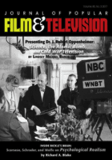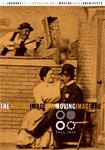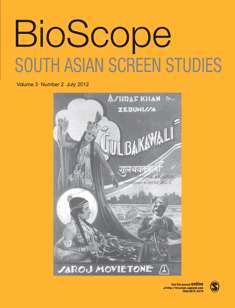
FILM CRITICISM
Scope & Guideline
Transforming Film Analysis for a New Era
Introduction
Aims and Scopes
- Interdisciplinary Critique of Film:
The journal embraces an interdisciplinary approach, merging insights from cultural studies, media studies, philosophy, and sociology to analyze films and their societal implications. - Focus on Cinematic Techniques:
A consistent focus on the technical aspects of filmmaking, including camera movements, editing styles, and sound design, which are explored to understand their impact on narrative and viewer experience. - Cultural and Historical Contexts:
The journal emphasizes the importance of context, examining films within their historical, political, and cultural frameworks to uncover deeper meanings and influences. - Exploration of Emerging Media:
The journal is interested in how new technologies, such as virtual reality and streaming platforms, reshape cinematic experiences and how these developments influence traditional film criticism. - Diverse Perspectives on Global Cinema:
The journal seeks to highlight diverse voices and perspectives, particularly from underrepresented filmmakers and regions, to broaden the understanding of cinema as a global phenomenon.
Trending and Emerging
- Impact of Streaming Media:
With the rise of streaming platforms, there is an increasing focus on how these technologies transform viewing habits, production practices, and the overall landscape of film consumption. - Intersection of Film and Identity:
Emerging themes around identity, including race, gender, and sexuality, are becoming more prominent, reflecting a broader societal conversation and the importance of representation in cinema. - Virtual and Augmented Realities:
As technology advances, there is a growing interest in the intersection of film with virtual and augmented realities, exploring how these mediums affect storytelling and audience engagement. - Documentary and Expanded Forms:
The exploration of new documentary forms and practices, particularly in response to contemporary crises such as the COVID-19 pandemic, highlights an innovative approach to storytelling and reality. - Festival Culture and Politics:
An increase in articles discussing the aesthetics and politics of film festivals indicates a trend towards understanding how these events shape cinematic discourse and influence the industry.
Declining or Waning
- Traditional Auteur Theory:
There has been a noticeable decline in articles solely centered on auteur theory, signaling a shift towards more collaborative and contextual analyses of film, moving away from singular authorial focus. - Classic Film Analysis:
Analyses of classic films from the early to mid-20th century have become less frequent, suggesting a growing interest in contemporary cinema and its relevance to current societal issues. - Film Genre Studies:
While genre studies were once a staple of film criticism, there seems to be a waning interest in this area, with fewer papers exploring genre conventions and their evolution.
Similar Journals

Transnational Screens
Transforming Perspectives on Art and Communication WorldwideTransnational Screens is a premier academic journal published by Taylor & Francis Ltd, focusing on the dynamic intersections of visual arts, performing arts, and communication in a globalized context. Since its inception, the journal has garnered significant recognition, featuring in the Q1 category for Visual Arts and Performing Arts and Q3 for Communication as of 2023, reflecting its influential contributions to these fields. With a Scopus ranking placing it in the 78th percentile in Visual Arts and Performing Arts, this journal serves as a vital platform for researchers, professionals, and students aiming to explore the implications of transnational narratives in contemporary media and artistic practices. The journal is accessible to a diverse readership and promotes open dialogue through its commitment to publishing innovative and interdisciplinary research from 2020 to 2024. As a key resource for understanding the complexities of transnational screens, it invites submissions that push the boundaries of traditional scholarship and engage with pressing global issues through the lens of the visual and performing arts.

JOURNAL OF POPULAR FILM AND TELEVISION
Celebrating the Art of Storytelling in Popular Media.JOURNAL OF POPULAR FILM AND TELEVISION, published by Routledge Journals, Taylor & Francis Ltd, stands as a significant platform for academic discourse in the realms of cultural studies, visual arts, and performing arts. With its ISSN: 0195-6051 and an evolving digital presence indicated by its E-ISSN: 1930-6458, the journal has carved out a respected niche since its inception in 1978, continuing to contribute to scholarly discussions through 2024. Its impact within the academic community is underscored by a Q3 ranking in Cultural Studies and a Q2 ranking in Visual Arts and Performing Arts for 2023, highlighting its relevance across diverse fields. Notably, with a Scopus ranking placing it in the 74th percentile among visual arts and performing arts journals, it serves as an essential reference point for researchers, professionals, and students committed to the critical examination of film and television. Although not an open-access journal, it provides valuable insights and analysis that enrich understanding of popular media's impact on society. The journal's location in the United States, with a headquarters in Abingdon, England, further affirms its international scope and influence.

Cinemas d Amerique Latine
Fostering Scholarly Dialogues on Latin American Cinematic ArtCinemas d Amerique Latine is a pivotal academic journal dedicated to the exploration and critical analysis of Latin American cinema. Published by PRESSES UNIV MIDI-PUM in France, this journal serves as an essential platform for scholars, practitioners, and students to engage with the diverse and dynamic landscape of visual storytelling throughout Latin America. With a dedicated focus on the cultural, historical, and aesthetic dimensions of film in this region, Cinemas d Amerique Latine aims to foster a deeper understanding of the cinematic narratives that shape and reflect Latin American societies. The journal has garnered a respectable Q3 ranking in the Visual Arts and Performing Arts category according to the latest 2023 evaluations, signifying its growing impact and relevance in the field. Despite its current lack of open access options, contributors can expect a rigorous peer-review process, ensuring the publication of high-quality research. Researchers exploring the rich tapestry of Latin American cinema will find Cinemas d Amerique Latine to be an invaluable resource in advancing their studies and contributing to vital scholarly conversations.

Moving Image
Fostering Critical Dialogue in Visual CultureMoving Image is a distinguished academic journal published by University of Minnesota Press, dedicated to the exploration and critical analysis of visual culture. With an ISSN of 1532-3978 and an E-ISSN of 1542-4235, this journal plays a vital role in advancing scholarship in the fields of Conservation, Visual Arts, and Performing Arts, offering insights from its notable publication history from 2013 to 2019 and again from 2021 to 2022. While it currently does not offer open access options, the journal is recognized as a crucial platform for disseminating research, reflected in its rankings—#442/667 in Visual Arts and Performing Arts and #87/103 in Conservation according to Scopus. Despite its placement in the Q4 quartile for both fields, Moving Image remains a key resource for scholars, students, and practitioners interested in the intricate dynamics of moving images in contemporary culture. Its commitment to fostering dialogue and innovation in visual studies ensures its relevance and influence within the academic community.

CINEJ Cinema Journal
Pioneering Conversations in Cinematic Discourse.CINEJ Cinema Journal, published by the University of Pittsburgh Library System, stands as a pivotal platform for scholarly discourse in the dynamic field of cinema studies. With an ISSN of 2159-2411 and an E-ISSN of 2158-8724, this Open Access journal has been dedicated to disseminating high-quality research since its inception in 2011. CINEJ provides an essential resource for researchers, practitioners, and students alike, exploring varied dimensions of cinema, including its cultural, historical, and technological implications. The journal is committed to fostering interdisciplinary dialogue, making it a vital asset for those seeking to deepen their understanding of cinema as an art form and social phenomenon. By engaging with contemporary issues and trends in the cinematic landscape, CINEJ encourages contributions that illuminate the intersection of film and social inquiry, ensuring its relevance in today’s academic ecosystem.

CINEFORUM
Celebrating the Vibrancy of Visual and Performing ArtsCINEFORUM is a distinguished journal published by the FEDERAZIONE ITALIANA CINEFORUM, focusing on the vibrant field of Visual Arts and Performing Arts. With an ISSN of 0009-7039, this journal serves as a significant platform for researchers and practitioners interested in critical discussions and analyses pertaining to cinema and performance. Although coverage in Scopus discontinued in 2020, CINEFORUM has established its standing with a category ranking in the Q4 quartile for Visual Arts, reflecting its niche yet passionate readership in the arts community. Based in Bergamo, Italy, the journal aims to foster a deeper understanding of cinematic and performative texts, offering insights and scholarly contributions that enhance the discourse within these artistic domains. Catering to an audience that includes researchers, professionals, and students, CINEFORUM remains an essential resource for those looking to explore the intersection of theory and practice in cinema and performing arts.

SIGHT AND SOUND
Illuminating Film's Impact on SocietySIGHT AND SOUND is a prestigious journal published by the British Film Institute, dedicated to the exploration of cinema and its cultural significance. With an ISSN of 0037-4806 and an E-ISSN matching the same, this journal has been a critical platform for film studies since its inception, contributing valuable insights to the realms of visual arts and performing arts. Despite its discontinuation in the Scopus database post-2021, SIGHT AND SOUND commands respect within its field, currently holding a Q3 rank among Visual Arts and Performing Arts journals. Operating from 21 Stephen Street, London W1P 1PL, England, it serves as a vital resource for researchers, professionals, and students looking to deepen their understanding of film theory, critique, and history. While access to its articles is not open, the journal continues to influence the discourse in film studies, making it a significant asset in academic and professional circles.

Bioscope-South Asian Screen Studies
Illuminating the Rich Tapestry of South Asian CinemaBioscope-South Asian Screen Studies is an influential journal dedicated to advancing the field of screen studies in the South Asian context, published by SAGE Publications India Pvt Ltd. With an ISSN of 0974-9276 and an E-ISSN of 0976-352X, this journal spans a convergence of scholarly research from 2010 to 2024, providing a significant platform for interdisciplinary dialogue. Holding a Q3 rating in Communication and a Q2 rating in Visual Arts and Performing Arts in the 2023 category quartiles, it ranks 212th in its field on Scopus, reflecting its vital contribution to academic discourse. Bioscope aims to explore and critically analyze the rich tapestry of South Asian cinema, media, and performance arts, offering researchers, professionals, and students a valuable resource for deepening their understanding of regional and global cinematic narratives. Readers will find insightful articles that probe the cultural, social, and political dimensions of screen studies, making this journal an essential reference for anyone engaged in the evolving landscape of South Asian visual culture.

Etica & Cine
Exploring the Ethical Lens of CinemaEtica & Cine is a distinguished open-access journal published by the University of Buenos Aires, Faculty of Psychology, dedicated to the interdisciplinary field of ethics in cinema and visual culture. With the ISSN 2250-5660 and E-ISSN 2250-5415, this journal has been a vital platform for researchers, professionals, and students since its inception in 2011, providing a space for critical discourse surrounding the ethical dimensions of film and media. The journal aims to foster scholarly dialogue by publishing high-quality articles that explore the philosophical, social, and psychological implications of filmic representations. While the journal's H-index is yet to be established, its commitment to open access ensures that valuable insights are readily available to a global audience, thus enhancing its significance in academic and professional circles. As the conversation around ethics in cinema continues to evolve, Etica & Cine stands as an essential resource for anyone engaged in this vital area of study.

CINEASTE
Bridging Theory and Practice in Film StudiesCINEASTE is a distinguished journal dedicated to the critical exploration of cinema, providing a platform for scholars, filmmakers, and enthusiasts to engage with the complexities of film studies. Established and published by CINEASTE, this periodical serves as a vital resource for those interested in the intersection of visual arts and performing arts. Although it is not currently offered as Open Access, CINEASTE remains a respected publication within the academic community, having been indexed in Scopus until 2016. With an ISSN of 0009-7004, it has established itself despite its lower ranking in the arts and humanities category, reflecting the competitive nature of this field. Researchers, students, and professionals alike will find ample opportunities for insightful discussion and scholarly contributions to the evolving landscape of cinematic discourse. CINEASTE continues to uphold its mission of enhancing film scholarship, making it a crucial reference point for anyone eager to deepen their understanding of cinema's artistic and cultural significance.